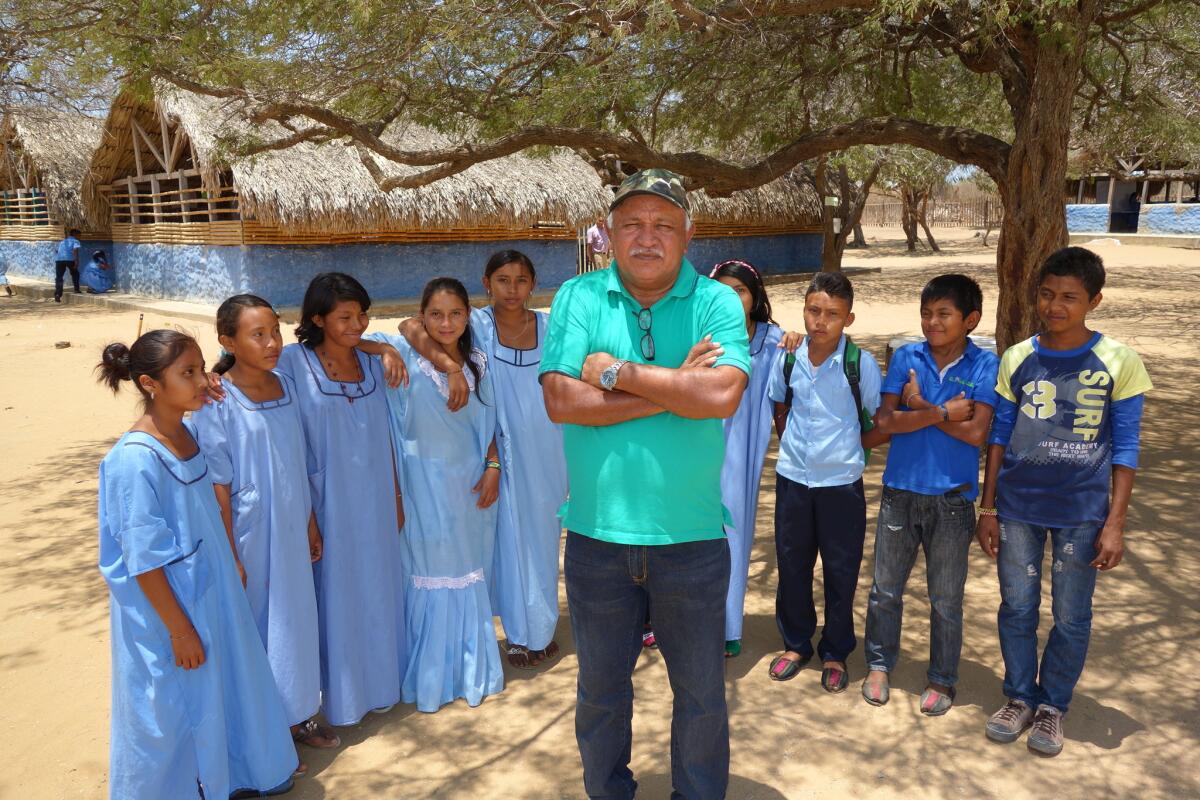Old Colombian languages, customs get newfound respect

Nelson Iguaran, director of the El Arroyo bilingual school near Riohacha, Colombia, where first through eighth graders are taught in Spanish and Wayuu naike.
- Share via
Reporting from RIOHACHA, Colombia — It was another day at the office for Elion Uriana, a palabrero, or tribal judge, in Colombia’s Wayuu indigenous community. A leader of his goat-herding clan, he was considering the aftermath of an arranged marriage gone bad.
“The parents of the groom had given 60 goats as dowry to the family of the bride. But the girl ran out on him a month after the ceremony and took up with another boy, a very bad deal,” said Uriana, 42. “The bride’s parents blamed the groom for mistreatment, but in the end there was no reconciliation and so they have to return those goats.”
Uriana had helped arrange the marriage, also part of his function as palabrero, which translates as “the word.” Uriana said that when it comes to matrimony, freedom of choice is anathema to Wayuu culture: “All our marriages are arranged by the families and the couple has to live by that.”
Uriana’s role of mediator is crucial to the Wayuu, one of 65 native groups in Colombia. His other tasks include resolving land disputes, monitoring debt payments and dividing lumber and other communal assets. “My duty is to mediate the peaceful resolution of conflicts. The traditional legal system is one thing; we Wayuus have our own.”
Numbering 300,000, the Wayuu native group is Colombia’s largest, accounting for more than 40% of the population of the northeastern province of La Guajira. The community also inhabits parts of neighboring Venezuela.
Not so many years ago, Wayuu customs such as palabreros were looked down upon by most Colombians, part of a condescending attitude in general toward native groups. But after decades of neglect, experts on the country’s aboriginal cultures say, more respect finally is being paid.
For Colombia’s native peoples, a watershed event was the 2010 enactment of the Language Law, which made preservation of the customs and languages of the Wayuu and the other native communities a national priority. The law was passed after warnings that up to half of the indigenous idioms in Colombia faced extinction unless measures were taken to preserve them.
Also in 2010, the tribal judges were recognized by the United Nations’ cultural arm UNESCO as part of the world’s cultural heritage, providing added impetus to tribal rights and the struggle for cultural preservation.
“Each native language gives a vision of the world, a way of perceiving and organizing things that we cannot afford to lose,” said Olga Ardila, a linguistics professor at National University of Colombia in Bogota. “And there is also the social function of language, how it binds communities together.”
The law led to the cataloging by the Ministry of Culture of all the country’s native idioms and customs, as well as several dialects of Afro-Colombians and criollos (people of Spanish descent). Completed in 2013, it was the first such update since the 1950s, said Moises Medrano, the ministry’s director of communities. The ministry also produced a computer application with basic greetings in 65 native tongues.
“What we are promoting is more interchange between native speakers and non-speakers so that community members feel more pride in their heritage and in the diversity of Colombia’s indigenous languages,” Medrano said.
The ministry also has made a push to promote bilingual education in native communities. The Wayuu are perhaps the most advanced in primary education, with a dozen schools mostly in and around the provincial capital, Riohacha, where classes are conducted in Spanish and Wayuu naike.
At one such school in the El Arroyo barrio five miles south of Riohacha, 270 Wayuu youths in grades one through eight attend classes conducted by bilingual teachers. The bilingual schools are a crucial element in preserving the Wayuu way of life amid outside pressures, school director Nelson Iguaran said.
“The attitude of people in general in our community is to undervalue themselves because they are indigenous,” Iguaran said. “But these kids go home and teach their parents words they didn’t know.”
One day in March, children were taught Wayuu traditions that Iguaran said place the collective good above all else. Also discussed were authority figures including sonãdoras, or dreamers, the matriarchal figures whose dreams can determine a community’s future course of action.
They were also taught the myth that the weaving talents of Wayuu women — so evident in the colorful mochillas, or shoulder bags, sold on the streets of Riohacha — were handed down from a waleket, or supernatural spider.
Consuelo Vengoechea, an anthropology professor at National University of Colombia, said the Culture Ministry’s efforts are positive but inadequate. The Education Ministry, she said, should train more bilingual teachers and stop trying to impose the “education models that work in the cities.”
“Ancestral knowledge of indigenous pueblos should be taught in their schools to emphasize the autonomy of these cultures,” Vengoechea said.
Maidoll Arredondo, director of FDHC Guajira, an indigenous rights advocacy group, said the bilingual education initiative has provided a rare ray of hope in a province beset by poverty, organized crime, drought and government neglect.
“The situation here is critical. Estimates are that 60% of Wayuu children suffer some degree of malnutrition,” Arredondo said, and climate change has hit the region hard. “It used to rain during four months of the year, but in 2014 it rained only twice. This has been disastrous for people who need water for pasture and farming.”
Kraul is a special correspondent.
More to Read
Sign up for Essential California
The most important California stories and recommendations in your inbox every morning.
You may occasionally receive promotional content from the Los Angeles Times.












